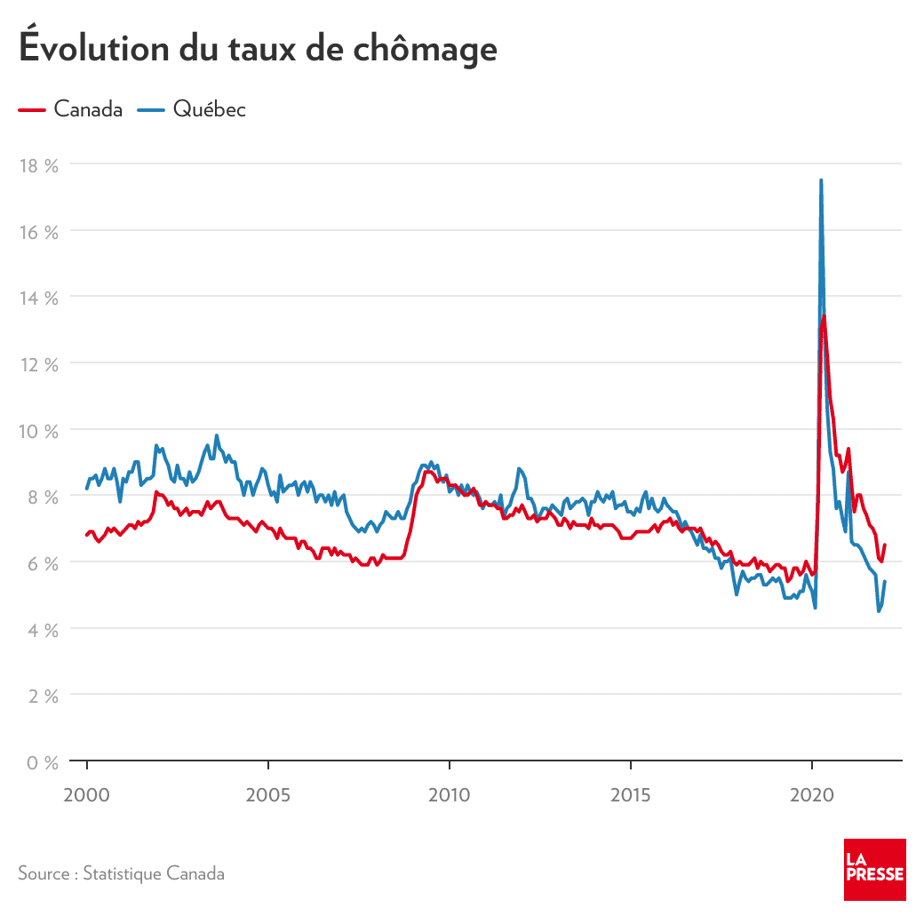
(OTTAWA) Canada’s unemployment rate was 5.4% in August, the first increase in seven months as the economy began to slow.
Updated yesterday at 2:17 pm.
The economy lost 40,000 jobs last month, Statistics Canada said Friday in its latest labor force survey. Losses are concentrated in the public sector.
The unemployment rate was 4.9% in July, its lowest level since comparable data became available in 1976.
Employment fell in British Columbia, Manitoba and Nova Scotia, but rose in Quebec. In addition to the 27,000 jobs created in the province – all part-time – more Quebecers are looking for work and the unemployment rate is measured at 4.5%, up from 0.4 percentage points.
Other provinces showed little change.
August marks the third straight month of job losses in Canada. Bank of Montreal economist Saul Guatieri said the economy is starting to show some weakness after being remarkably strong in the first half.
The economy was doing very well until a few months ago and now it looks like it has tanked.
Saul Guatieri is an economist at the Bank of Montreal
Employment gains in professional, scientific and technical services were offset by declines in educational services and construction, according to Statistics Canada.
CIBC notes that the 50,000 job losses in education reflect seasonal difficulties and may return later.

Attention Bank of Canada
The Bank of Canada is monitoring all developments in the economy as it conducts a campaign to raise interest rates in an attempt to control hyperinflation. Economic slowdown is expected due to rise in interest rates.
“Another labor force survey is due to be released before the October meeting [de la banque centrale]At least one more rate hike is likely to be expected before a pause is observed,” CIBC economist Andrew Grantham said in an email.
Job losses were mainly concentrated among women aged 15 to 24 and men aged 55 to 64, but the participation rate remained stable overall, Statistics Canada said.
Average hourly earnings in August rose 5.4% from the same month last year, showing an acceleration from July’s 5.2% annual increase.
The pace of wage growth amid high inflation is “going to raise some eyebrows,” Guatieri said.
“This makes the Bank of Canada nervous about the inflation outlook, at least as we are subject to another 50 basis points rate hike at the end of October,” Ms. Guatieri.
Statistics Canada has warned that employers will face recruitment challenges as more Canadians reach retirement age. As of August, 307,000 Canadians had left their jobs for retirement at some point in the past year, up from 233,000 the year before.
The report also looked at the unemployment rate among immigrants who came to Canada in the last five years. That rate was 7.6%, the lowest for any August since comparable data became available in 2006.
The report also revealed that the percentage of workers who want to leave their jobs is increasing. According to the federal agency, 11.9% of permanent employees planned to leave their jobs in the next 12 months, nearly double the rate in January.
The Labor Force Survey also asked which job characteristics workers consider essential or most important. The top factor cited by respondents was salary and benefits, with 85.4% ranking it as the most important factor.
Statistics Canada notes that as more people return to the workplace, working exclusively from home is declining while the proportion of people working in a hybrid manner is increasing.





